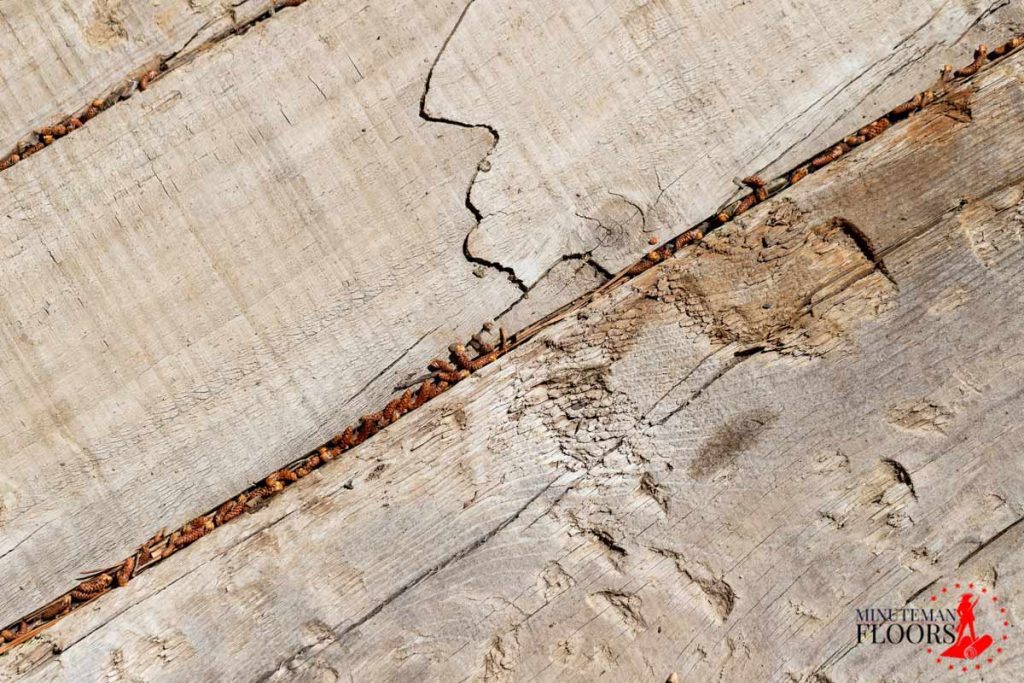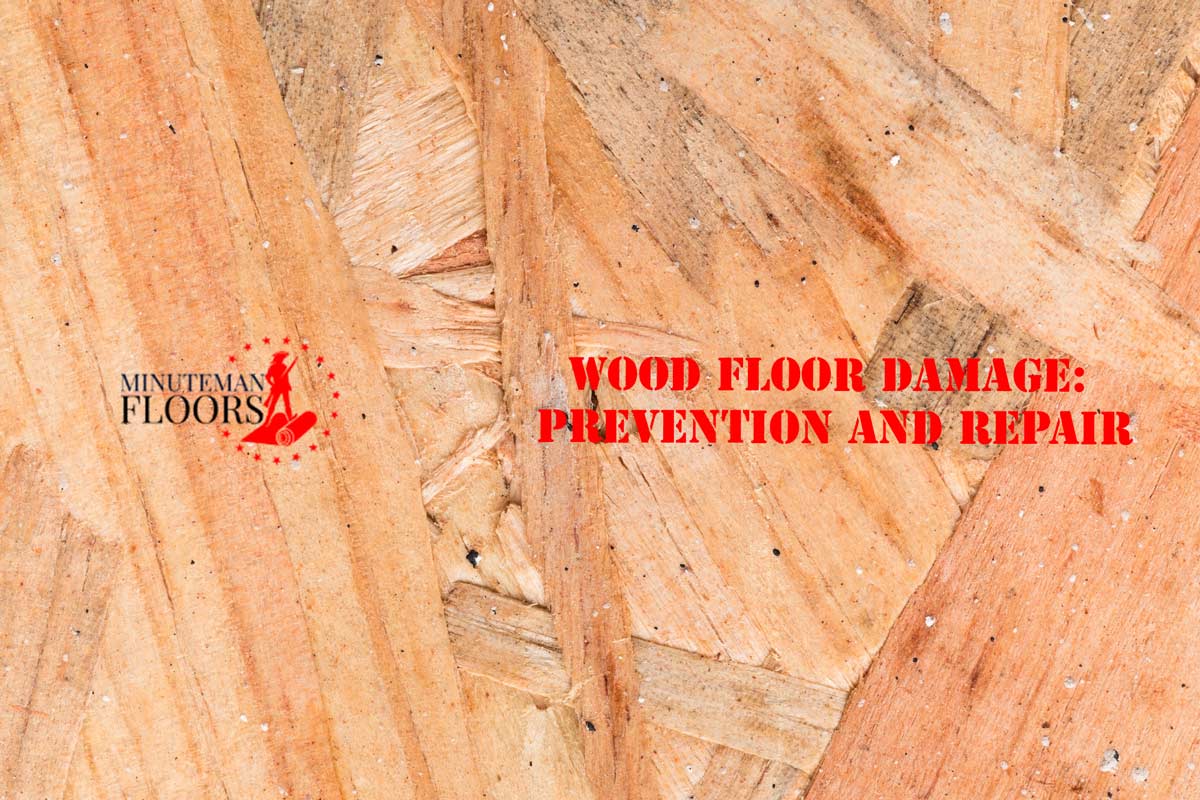Without a doubt, hardwood flooring is one of the most elegant and durable types of flooring that adds a timeless and classic look to any space. However, like any other flooring type, wood floor damage is not unlikely, especially if not maintained properly.
As hardwood flooring is one of the most expensive choices for flooring, it is highly recommended to learn about different types of wood floor damage, assess your hardwood floor for any sign of it, and instantly repair the damaged wood planks.
So, in this article, we have put together a simple guide on different kinds of hardwood flooring damage and give you some tips about how to prevent it or fix it.
Make your hardwood floor look as good as new with our very special hardwood floor refinishing services and wooden floors repairs in Manchester, New Hampshire. Click on the link or call for further information.
What Are Different Types of Wood Floor Damage?
Some damages are very common, such as scratches on wood floor, and they can usually be repaired more easily.
However, some other damages mostly happen in case of lack of proper maintenance, like water damage on wood or hardwood floor termite damage. These problems are more difficult to deal with.
So, if you are enjoying a beautiful hardwood floor, it is essential for you to learn about possible hardwood damages, how to prevent them, and how to repair them.
Hardwood Floor Surface Damages
Various kinds of surface damages can commonly happen to the surface of your hardwood floor.
- Scratch in Hardwood
Scratches on hardwood floor often happen as a result of heavy foot traffic, dragging furniture, not using protective paddings under the furniture, pets’ nails, and some kids’ toys.
Fortunately, these scratches usually affect the finish of the flooring, not the wood itself. Therefore, hardwood floor scratch repair can be done with some special wooden floor scratch remover kits for minor ones and professional refinishing for bigger ones.
- Gouge and Dent in Wood Floor
Sometimes shallow depressions are created on the wood surface normally due to heavy furniture or other objects like high heels. If these indentations are deeper and more severe, they cause gouges in the hardwood.
Both dents and gouges compromise the appearance and structural integrity of your wood floor and should be dealt with quickly to avoid further damage.
For hardwood dent repair, there are a few methods:
- Steaming the affected area: For small dents, sometimes they are steamed to make the wood fibers swell and, as a result, the dent rises.
- Putty or wood filler: Applying wood filler or putty that matches the color of the hardwood can hide the dent pretty well. After smoothing it out and giving it some time to dry, sand it carefully to make it level.
On the other hand, fixing a gouge in hardwood floors mostly requires refinishing. You should hire professionals to sand and refinish the floor or replace the affected planks.
- Hardwood Flooring Wear and Tear
Daily wear and tear on wood flooring causes it to lose its shine and show little abrasions over time. That’s why you should consider regular maintenance and occasional refinishing.
When the hardwood finish wears off, usually after a few years, the wood itself is prone to surface damage. So, to avoid more serious problems, like dents and gouges, refinishing is necessary. Besides, try not to use harsh chemicals when cleaning the wood floor as they might strip away the finish and coatings.
What’s more, if you want to keep your hardwood floor smooth and shiny, don’t forget proper cleaning with appropriate products.
Wood Floor Water Damage
Hardwood floor water damage can cause serious problems that mostly require costly repair and replacement of the water damaged timber floors. These can include:
- Stains: If water, or any other liquids, spills or leaks on the wood floor, you should clean up the spill and prevent the leak as quickly as possible, otherwise there will be stains and discolorations. Professional sanding and refinishing can remove the existing stains.
- Cupping: Another problem caused by excessive moisture and/or water damage is when the edges of the planks rise. Sometimes when the floor dries, the planks go back to their normal shape and become flat again. However, in more serious cases, you have to replace the wooden boards.
- Warping: When the hardwood planks are exposed to moisture and water for a long time or there’s a problem with subfloor ventilation, the boards get badly twisted and distorted. This is called wood warping. This mostly requires professionals to fix it.
Hardwood Flooring UV Damage
Fading and discoloration are common results of prolonged exposure to sunlight. This makes your wood floor lose its original color and uniform appearance.
You can prevent it by using UV-protective coatings and curtains or any other window coverings. And, if fading happens, you can solve it by refinishing, staining, and even replacing the floorboards in severe cases.
Read Different Types of Woods in Hardwood Flooring to get more familiar with wood species and their characteristics.
Structural Damage

Hardwood floor structural damage can refer to:
- Gaps and squeaks: Fluctuations in temperature and humidity can cause some gaps between the wooden planks. These gaps are not only an eyesore but also cause squeaking noises. An experienced flooring contractor takes into account temperature and humidity before installation to reduce the possibility of gaps to a minimum.
- Cracking: Wooden floorboards may sometimes crack due to changes in temperature, moisture fluctuations, and some other reasons, like structural problems. Flooring experts help you find out the cause of this wood floor damage. The solutions involve filling the cracks, sanding and refinishing, and replacement.
- Subfloor damage: The floor beneath the hardwood flooring may get damaged by water, pests, etc. Such subfloor problems carry over to the floor itself and compromise its integrity and appearance. In these cases, you have to first address the subfloor issues and then fix the hardwood floor.
Insect Infestation and Fungal Growth
Excessive moisture, humidity, higher temperatures, gaps and cracks, low-quality wood, and improper cleaning and maintenance can cause termites and beetles to infest your hardwood flooring. Damage by these insects can cause the hardwood flooring to lose its stability and structural integrity.
To fix the damaged floor, you need to first get rid of the insects. There are different methods such as using chemical pesticides and insecticides, fumigation, heat/freezing treatment, and removing the hardwood floor.
The growth of mold and mildew is another problem that can happen due to high humidity and moisture. You have to first find the source of the moisture and then let the floor dry. After that, apply mold/mildew removal products to solve the problem. Also, make sure your place and the subfloor get adequate ventilation.
The fungal growth in wood not only damages the structure of the floor but also may lead to health problems, like allergic reactions and respiratory issues, especially for sensitive groups.
Overall, wood floor damage is an important matter that must be addressed promptly. Seeking a flooring expert’s opinion and professional flooring services is always recommended to ensure the damage is totally fixed and the root causes of the damage are detected to prevent the reoccurrence of the same issue in the future.
Did you know you will get a one-year warranty on our flooring installation services? Call to discuss your project with an accomplished flooring expert in Manchester, NH.
Essential Tips to Prevent Hardwood Floor Damage
- Hardwood flooring installation is a complicated process that requires skills and specialized equipment. Problems in the installation give rise to different flooring damages later. So, avoid DIY hardwood floor installation.
- Never use harsh chemicals on wooden floors.
- Vacuum or sweep the floor regularly.
- Have a schedule for your hardwood floor assessment and inspection to detect any damage, like water damage, and address it ASAP. Don’t forget to inspect the subfloor as well.
- Clean up spills quickly.
- Use mats on the foot of the kitchen sink, entryways, stairs, and other high-traffic places.
- Fixing hardwood floor scratches, dents, gouges, and other damages immediately will save you from extensive and expensive repairs and replacements.
- Don’t forget to use furniture pads and other protective methods to prevent these heavy objects from damaging the flooring.
- Periodic refinishing is necessary to keep away serious damage to the wood and restore the hardwood's original appearance.
- Follow the instructions from your hardwood floor contractor for correct maintenance and inspection. And, seek professional help in case of severe problems.
FAQs Regarding Fixing and Maintaining Hardwood Flooring
Here are the answers to some of your most common questions about dealing with wood floor damage.
What Are Hardwood Cupping and Crowning?
Cupping happens when the edges of the wood boards rise and cause a concave shape due to moisture damage or temperature changes.
On the other hand, when the wood fibers suddenly lose their moisture and become dry, the opposite will happen. The center of the planks rises and leads to a convex shape. This is called crowning.
You usually need a flooring expert to find the cause of cupping and crowing and suggest the best solution for it.
What Is Hardwood Refinishing?
During hardwood refinishing, a thin surface layer of the boards is sanded to remove the scratches and other surface damage. Then, a new finish and coating are applied to add to its durability and give the floor a fresh look.
How Can I Repair Creaking Floorboards?
First, you need to find the exact boards causing the noise. Then, assess them for any loose nails, gaps, or subfloor problems to see why they are creaking.
Tighten the nails, fill the gaps with putty or wood fillers, reduce the friction between the planks with powdered graphite or talcum, and fix and secure the subfloor. If they are still creaking, seek professional help.
What Indoor Temperature and Humidity Are Suitable for Hardwood Flooring to Prevent Damage?
A temperature range of 60 to 80 °F and 35% to 55% humidity level are ideal for most hardwood floors. However, you should keep the humidity and temperature consistent and avoid sudden changes that can lead to warping, cracking, gaps, etc.
What Are the Signs of Hardwood Flooring Subfloor Damage?
If it is possible to check the subfloor directly, look for any discoloration, mold/mildew, termites, soft spots, unusual unevenness, and any other new conditions.
But if you do not have direct access to the subfloor for visual inspection, you can look for visible signs on the hardwood flooring. Keep an eye open for any change in the shape of floorboards, discoloration, gaps between the planks, soft spots, moisture, and unevenness. Besides, squeaks and creaks may also mean there is a problem with the subfloor.
How Often Does My Hardwood Floor Need Refinishing?
It depends on a few factors such as foot traffic and the type of hardwood. However, it is recommended to inspect your hardwood flooring protective finish layer every 2 or 3 years to see if there is any need for refinishing.
Where Is the Best Hardwood Flooring Services in Manchester, New Hampshire?
Now that you have learned the necessary points about wood floor damage, prevention, and repair, it’s time to inspect your hardwood floor and address the issues. And, if you need any professional help, Minuteman Floors is only a phone call away from you.
We have been repairing, installing, and refinishing hardwood flooring for both commercial and residential areas in Manchester and some nearby cities in New Hampshire for years. We’ll visit you at your convenience and give our honest opinion about your floor conditions.
Call (603) 782-1942 or fill out the form and we will contact you.

